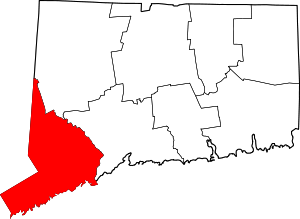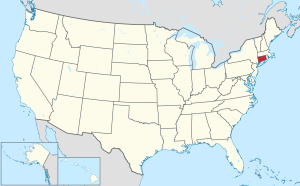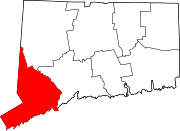Fairfield County, Connecticut: Difference between revisions
No edit summary |
No edit summary |
||
| Line 17: | Line 17: | ||
'''Fairfield County''' is located in the southwestern corner of the [[U.S. state]] of [[Connecticut]]. Its population according to the 2000 census was 882,567, but a 2006 survey put the population at 905,000. It is the most populous county in the State of Connecticut. It is part of the [[New York Metropolitan Area]]. |
'''Fairfield County''' is located in the southwestern corner of the [[U.S. state]] of [[Connecticut]]. Its population according to the 2000 census was 882,567, but a 2006 survey put the population at 905,000. It is the most populous county in the State of Connecticut. It is part of the [[New York Metropolitan Area]]. |
||
While Fairfield County is one of the wealthiest counties in the country,[[Luxury Real Estate]][ |
While Fairfield County is one of the wealthiest counties in the country,[[Luxury Real Estate]][http://www.prudentialct.com/AgentDetails.aspx?AK=5037 Fairfield Beach] it is also home to less affluent, working class areas such as Bridgeport. The city of Bridgeport is mostly home to minorities and is a perfect example of Connecticut's famed "wealth gap," as all other towns in Fairfield County are considered affluent by national standards. |
||
The towns in Fairfield County bordering [[Long Island Sound]] are sometimes referred to as '''[[Gold Coast (Connecticut)|The Gold Coast]]'''. |
The towns in Fairfield County bordering [[Long Island Sound]] are sometimes referred to as '''[[Gold Coast (Connecticut)|The Gold Coast]]'''. |
||
Revision as of 12:25, 11 May 2007
Fairfield County | |
|---|---|
 Location within the U.S. state of Connecticut | |
 Connecticut's location within the U.S. | |
| Coordinates: 41°14′N 73°22′W / 41.23°N 73.37°W | |
| Country | |
| State | |
| Founded | 1666 |
| Seat | none; Connecticut counties do not have a county government |
| Population (2000) | |
| • Total | 882,567 |
Fairfield County is located in the southwestern corner of the U.S. state of Connecticut. Its population according to the 2000 census was 882,567, but a 2006 survey put the population at 905,000. It is the most populous county in the State of Connecticut. It is part of the New York Metropolitan Area.
While Fairfield County is one of the wealthiest counties in the country,Luxury Real EstateFairfield Beach it is also home to less affluent, working class areas such as Bridgeport. The city of Bridgeport is mostly home to minorities and is a perfect example of Connecticut's famed "wealth gap," as all other towns in Fairfield County are considered affluent by national standards.
The towns in Fairfield County bordering Long Island Sound are sometimes referred to as The Gold Coast.
The county's largest cities are Bridgeport, Stamford, Danbury, and Norwalk. Together these cities contain about 420,000 people - almost half the population of the county.
As is the case with all eight of Connecticut's counties, there is no county government, and no county seat. In Connecticut, towns are responsible for all local government activities, including fire and rescue, snow removal and schools. In a few cases, neighboring towns will share certain resources. However, Fairfield County is merely a group of towns on a map, and has no particular authority.
Geography
According to the U.S. Census Bureau, the county has a total area of 2,168 km² (837 mi²). 1,621 km² (626 mi²) of it is land and 547 km² (211 mi²) of it (25.23%) is water.
The terrain of the county trends from flat near the coast to hilly and higher near its northern extremity. The highest elevation is 1,290 feet (393 m) above sea level along the New York state line south of Branch Hill in the Town of Sherman; the lowest point is sea level itself.
Adjacent Counties
- Litchfield County (north)
- New Haven County (east)
- Westchester County, New York (southwest)
- Putnam County, New York (west)
- Dutchess County, New York (northwest)
Politics
| Year | Republican | Democratic |
|---|---|---|
| 2004 | 47.3% 189,605 | 51.4% 205,902 |
| 2000 | 43.1% 159,659 | 52.3% 193,769 |
| 1996 | 41.4% 144,632 | 48.9% 172,337 |
| 1992 | 42.8% 175,158 | 39.1% 160,202 |
| 1988 | 59.0% 221,316 | 39.9% 149,630 |
| 1984 | 65.8% 257,319 | 33.8% 132,253 |
| 1980 | 54.9 201,997 | 33.7% 124,074 |
| 1976 | 58.1% 209,458 | 41.2% 148,353 |
| 1972 | 64.0% 233,188 | 34.3% 125,128 |
| 1968 | 51.8% 173,108 | 41.7% 139,364 |
| 1964 | 39.2% 125,576 | 60.8% 194,782 |
| 1960 | 53.4% 167,778 | 46.6% 146,442 |
Cities, towns, sections of towns and villages*
- Bethel (Town)
- Bridgeport (City)
- Black Rock
- North End
- Newfield
- Ox Hill
- Hollow
- Mill Hill
- Brookfield (Town)
- Danbury (City)
- Germantown
- Mill Plain
- Little Brazil
- Darien (Town)
- Noroton
- Noroton Heights
- Tokeneke
- Easton (Town)
- Aspetuck
- Sport Hill
- Fairfield (Town)
- Southport
- Greenfield Hill
- Greenwich (Town)
- Byram
- Cos Cob
- Old Greenwich
- Riverside
- Back Country
- Belle Haven
- Monroe (Town)
- Stepney
- Stevenson
- New Canaan (Town)
- Silvermine (part)
- New Fairfield (Town)
- Newtown (Town)
- Sandy Hook
- Dodgingtown
- Botsford
- Norwalk (City)
- Cranbury
- East Norwalk
- Rowayton
- Silvermine (part)
- South Norwalk
- Redding (Town)
- Georgetown (most)
- Redding Ridge
- West Redding
- Five Points
- Ridgefield (Town)
- Shelton (City)
- Huntington
- White Hills
- Sherman (Town)
- Stamford (City)
- Belltown
- Downtown
- The Cove
- Glenbrook
- Newfield
- North Stamford
- East Side
- Shippan
- Shippan Point
- Springdale
- South End
- Turn of River
- West Side
- Stratford (Town)
- Hawley Lane
- Lordship
- Paradise Green
- Putney
- Oronoque
- Trumbull (Town)
- Long Hill
- Nichols
- Tashua
- Weston (Town)
- Georgetown (part)
- Westport (Town)
- Greens Farms
- Saugatuck
- Wilton (Town)
- Georgetown (part)
- Silvermine (part)
* Villages are census division, but have no separate corporate existence from the towns they are in.
Transportation
Mass transit
With the county's major thoroughfares, Interstate 95 and the Merritt Parkway, increasingly clogged with traffic, state officials are looking toward mass transit to ease the traffic burden. In the 2005 and 2006 sessions of the Legislature, massive appropriations were made to buy more rail cars for the Metro-North New Haven Line and branch lines. Ferry lines for some commuters in and out of Stamford are also in development.
New office buildings are being concentrated near railroad stations in Stamford, Bridgeport and other municipalities in the county to allow for more rail commuting. Proximity to Stamford's Metro-North train station was cited by the Royal Bank of Scotland as a key reason for locating its new U.S. headquarters building in downtown Stamford; construction on the office tower started in late 2006.
Rail
Commuter Rail is perhap's Fairfield County's most important transportation artery, as it allows many of its affluent residents an efficient ride to Grand Central. Service is provided on Metro-North's New Haven Line, and every town on the shoreline has at least one station. Connecting lines bring service to New Canaan from Stamford and to Danbury from South Norwalk. Many trains run express from New York to Stamford, making it an easy 35 minute ride. Stamford and Bridgeport are also served by Amtrak, and both cities see a significant number of boardings.
Bus service
Connecticut Transit (CTTRANSIT)[1] runs local and inter-city buses to all parts of the county.
Major roads
Traffic is widely seen as one of the most significant problems in Fairfield County.
Boston Post Road
- U.S. Route 1, known by various names along its length, most commonly "Boston Post Road", is the oldest east-west route in the county, running through all of its shoreline cities and towns. Since the route runs along the East Coast, for uniformity's sake, east is officially called "North" and west is officially "South".
Also potentially confusing are the numerous names that Route 1 takes as it goes from town to town. In Greenwich, for instance, it is called Putnam Avenue. In Stamford i becomes Main Street or Tresser Boulevard. In Darien and Fairfield it is called Boston Post Road or "the Post Road". In Norwalk it is known as Connecticut Avenue.
Interstate 95
- Interstate 95, known within Connecticut as the Connecticut Turnpike or the Governor John Davis Lodge Turnpike, crosses the state approximately parallel to U.S. Route 1. The road is most commonly referred to as "I-95". The highway is six lanes (sometimes eight lanes) throughout the county. It was completed in 1958 and is often clogged with traffic particularly during morning and evening rush hours.
With the cost of land so high along the Gold Coast, state lawmakers say they don't consider widening the highway to be fiscally feasible, although occasional stretches between entrances and nearby exits are now sometimes connected with a fourth "operational improvement" lane (for instance, westbound between the Exit 10 interchange in Darien and Exit 8 in Stamford). Expect similar added lanes in Darien and elsewhere in the Fairfield County portion of the highway in the future, lawmakers and state Department of Transportation officials say.
Merritt Parkway
The Merritt Parkway, also known as "The Merritt" or Connecticut Route 15, is a truck-free scenic parkway that runs through the county parallel and generally several miles north of Interstate 95. Like I-95, the route typically slows down during rush hours. It is not uncommon for traffic to come to a complete stand still without the help of construction or an accident.
The interchange between the Merritt Parkway and Route 7 in Norwalk was completed around the year 2000. The project was held up in a lawsuit won by preservationists concerned about the historic Merritt Parkway bridges. It is now exit 39 off the Merritt, and exit 16 off I-95.
Interstate 84
Interstate 84, which runs through Danbury, is scheduled to be widened to a six-lane highway at all points between Danbury and Waterbury. State officials say they hope the widening will not only benefit drivers regularly on the route but also entice some cars from the more crowded Interstate 95, which is roughly parallel to it. Heavier trucks are unlikely to use Interstate 84 more often, however, because the route is much hillier than I-95 according to a state Department of Transportation official.
U.S. Route 7
With its southern terminus at Interstate 95 in central Norwalk, U.S. Route 7 heads north through Wilton, Ridgefield, and Danbury to points north. In Danbury and almost all of Norwalk, the route is a highway but it becomes a four-lane road just south of the Wilton-Norwalk border and up to Danbury. There is significant opposition to making the route a highway in Wilton and Ridgefield.
Connecticut Route 8
Route 8 terminates (or starts) in central Bridgeport and goes north through Trumbull and Shelton, then beyond the county through some of "The Valley" towns of the Naugatuck River Valley to Waterbury and beyond. Construction of the route provided some impetus for the creation of office parks in Shelton and home construction there and in other parts of The Valley.
Connecticut Route 25
Demographics
As of the census² of 2000, there were 882,567 people, 324,232 households, and 228,259 families residing in the county. The population density was 545/km² (1,410/mi²). There were 339,466 housing units at an average density of 209/km² (542/mi²). The racial makeup of the county was 79.31% White, 10.01% Black or African American, 0.20% Native American, 3.25% Asian, 0.04% Pacific Islander, 4.70% from other races, and 2.49% from two or more races. 11.88% of the population were Hispanic or Latino of any race.
There were 324,232 households out of which 34.20% had children under the age of 18 living with them, 55.50% were married couples living together, 11.50% had a female householder with no husband present, and 29.60% were non-families. 24.00% of all households were made up of individuals and 9.40% had someone living alone who was 65 years of age or older. The average household size was 2.67 and the average family size was 3.18.
In the county the population was spread out with 25.60% under the age of 18, 7.00% from 18 to 24, 30.90% from 25 to 44, 23.30% from 45 to 64, and 13.30% who were 65 years of age or older. The median age was 37 years. For every 100 females there were 93.40 males. For every 100 females age 18 and over, there were 89.60 males.
The median income for a household in the county was $65,249, and the median income for a family was $77,690. Males had a median income of $51,996 versus $37,108 for females. The per capita income for the county was $38,350. About 5.00% of families and 6.90% of the population were below the poverty line, including 8.30% of those under age 18 and 6.60% of those age 65 or over.
Hospitals in the county
- Bridgeport Hospital
- Danbury Hospital
- Greenwich Hospital
- Norwalk Hospital
- St. Vincent's Medical Center (Bridgeport) in Bridgeport
- Stamford Hospital
References
External links
Major media in the county
Countywide
Daily newspapers covering the county
- The Advocate of Stamford - STAMFORD edition -- published by Southern Connecticut Newspapers Inc., a subsidiary of the Tribune Company
- The Advocate of Stamford - NORWALK edition
- Connecticut Post -- owned by Media General Group
- The Hartford Courant (occasionally covers Fairfield County) -- owned by the Tribune Company
- The Hour of Norwalk registration required -- controlled by a trust under the ultimate authority of Norwalk Probate Court
- Greenwich Time -- published by Southern Connecticut Newspapers Inc., a subsidiary of the Tribune Company
- New York Daily News (occasionally covers Fairfield County)
- New York Post (occasionally covers Fairfield County)
- New York Times (occasionally covers Fairfield County)
- The News-Times of Danbury, owned by Ottaway Newspapers, a subsidiary of Dow Jones
Spanish language newspapers
- El Sol News countywide, based in Stamford
- El Canillita distributed across southwestern Connecticut
Broadcast media and cable television
Colleges
- Housatonic Community College in Bridgeport
- University of Bridgeport link
- University of Connecticut, Stamford campus
- Fairfield University
- Norwalk Community College
- St. Vincent's College in Bridgeport
- Sacred Heart University in Bridgeport
- Western Connecticut State University
Culture and the arts
Music: Orchestras in the county
- Greater Bridgeport Symphony. Founded in 1945, its concerts are held at Klien Memorial Auditorium in Bridgeport. The orchestra offers a free outdoors pops concert in the summer at Fairfield University. Gustav Meier has been with the GBSO for 35 years.
- Connecticut Grand Opera, a not-for-profit, professional opera company founded in 1993 and based in Stamford, where it performs at the Palace Theatre. On its web site, the CGO claims to offer "the most ambitious opera season of any company between New York and Boston."
- Danbury Symphony Orchestra. This orchestra does not have its own Web site and only part of a web page at the Danbury Music Center web site is devoted to it.
- Greenwich Symphony Orchestra. Begun in 1958 as the Greenwich Philharmonia, the orchestra has grown to 90 members who perform at the Dickerman Hollister Auditorium at Greenwich High School. It also performs a pops concert in the summer. David Gilbert has been music director and conductor since 1975.
- Norwalk Symphony Orchestra. Its concerts take place in a graceful, large "Norwalk Concert Hall" auditorium of Norwalk City Hall. Founded in 1939, the NSO remained primarily a community orchestra of volunteers. In 1956, the Norwalk Youth Symphony was created, and younger musicians often were invited to be part of the orchestra. Diane Wittry has been music director and conductor since 2002. For the past eight years she has held the same title at the Allentown (Pennsylvania) Symphony.
- Ridgefield Symphony OrchestraAnnually, the RSO presents four subscription concerts at the Anne S. Richardson Auditorium at Ridgefield High School, and two chamber music concerts at the Ridgefield Playhouse for the Performing Arts (only one is scheduled in the 2006-07 season), along with an annual "family concert" and performances in Ridgefield schools.
- Stamford Symphony Orchestra The SSO typically gives five pairs of classical concerts and three pops concerts a season at the 1,586-seat Palace Theatre. It also performs a concet for elementary school students and a family concert series.
History and culture links
Historic sites
Tourism links
- Coastal Fairfield County Convention and Visitors Bureau serves Stamford, Norwalk, Bridgeport, and Shelton and the towns of Greenwich, Darien, New Canaan, Wilton, Westport,Weston, Fairfield, Easton, Monroe, Stratford, and Trumbull.
- Northeast Connecticut Convention and Visitors Bureau, in Fairfield County, it serves Ridgefield, Redding, Newtown, Bethel, Brookfield, Danbury, Sherman and New Fairfield.
County business associations and institutions

